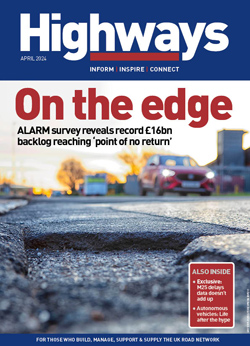Highways England’s chief executive, Jim O’Sullivan (pictured) has overseen some fantastic progress in his short time at the Government-owned company. However, as projects get shelved under a reprofiling of the works programme, the pressure could be starting to mount. Mr O’Sullivan talks exclusively to Dominic Browne about the road ahead for the Road Investment Strategy (RIS).
Jim O’Sullivan is a man with a broad perspective on transport and infrastructure, having spent a career within transportation, asset management and utility organisations and having been managing director at Heathrow Airport Holdings (formerly BAA) – Airports Division, and Edinburgh Airport. It is a perspective that will come in useful in the years ahead, as Highways England reaches a crunch point towards the end of the decade.
Following news of a large funding shortfall, Highways England has rescheduled the delivery of the current and first RIS (2015-2020), resulting in some schemes being brought forward or delayed, while six others have been shelved to undergo further analysis to make them meet benefit-cost ratio targets and two schemes are set to move into RIS2.
The changes have reduced the budget shortfall from £800m to around £600m, Mr O’Sullivan tells Highways, although he adds this is not a simple process of cost-cutting by moving the delivery of schemes around: ‘It’s more complex than that because, don’t forget, 10 schemes come forward. These 10 schemes will cause us to increase expenditure. People are very interested in our funding and its adequacy. Two-and-a-half years in, to have a £600m challenge on a £11.5bn capital programme is perfectly normal.’
Mr O’Sullivan spoke in his first interview with trade press since the reprofiling announcement and is, while not necessarily on a charm offensive, having to reassure some in the sector.
‘I think we sold this [reprofiling] to government on two benefits. The first is the benefit to users, which is that of not having to do all this work at the same time. There are seven schemes in production on the A47 for example.
‘The second is the benefit to the supply chain, which was of equal interest to government, and smooths the work flow. I will take the A47 as an example. If you a start work on seven sites you need all the same labour in all seven places at the same time. That is clearly not a good way to manage production. You would rather people move from job to job for each project.’
When asked if the problem rested with what the National Audit Office described earlier this year as the rushed planning behind the RIS in the run up to the 2015 election, Mr O’Sullivan responds: ‘It goes back to the timing of the RIS. If you are going to put together a five-year control period then you end up designing a lot of schemes at the same time and if you look at the earliest possible date for delivery you end up with them all going into production at the same time.
‘I am not necessarily sure [the RIS] was rushed. There was a certain element of pump priming. Every time you do a control period for the first time there is going to be a degree of invention about it. I am not sure
I agree it was rushed in terms of where we sit today. We sit in the halfway point of the RIS; in the round, what we have been asked to do is very deliverable.’
Some in the industry have suggested that greater early contractor involvement (ECI) could be a solution to some of the cost pressures Highways England faces.
However Mr O’Sullivan rejects the suggestion that this was a wake-up call on ECI, stating: ‘Firstly, I don’t think we need a wake-up call. I think we are doing reasonably well.’
Discussing how Highways England went about restructuring the RIS, Mr O’Sullivan says: ‘We went through the whole 111 schemes using the latest economic analysis. The benefit-cost ratio (BCR) is around 2.5-3. If any scheme falls below 1.5 I am required to write to Department for Transport (DfT) to say that it has fallen below that level. Those schemes can then be paused or subject to further analysis. It is right that we should give government the opportunity to revaluate them.
‘From the review, eight came out with low BCR. Six cannot satisfy the BCR and we have put them back for further analysis and we will see if two others can be included in RIS2.
‘I have never before written to the secretary of state, although I did almost once when a scheme reached 1.48, but I thought, this is ridiculous, am I really going to write to government because of this? The scheme did get built.’
The obvious question is why these schemes were included in the RIS in the first place if they had lower BCR levels than were allowed.
Mr O’Sullivan explains that as the RIS was put together several years ago, there have been subsequent improvements to Highways England’s regional traffic modelling and economic analysis, which have shone a new light on the benefits of these projects.
Highways England has its own department for economic analysis and shares its updated intelligence with the DfT. Its modelling is now ‘more detailed, with better algorithms’. One of the benefits of this is it helps the company develop a better understanding of traffic growth. However, controversially, Mr O’Sullivan suggests these models do not analyse the potential for induced traffic demand created by new road capacity: ‘Traffic growth is driven by economic growth and not by our roads programme,’ he says.
This perspective may have more to do with diplomacy with regards to the powers that be in the DfT than modern traffic modelling. As Mr O’Sullivan goes on to point out, the DfT ‘will have a broad agenda and a number of political objectives’ and the political, social and economic agenda behind network management and development for the strategic road network ‘cannot be decided by Highways England ’.
An alternative view comes from John Elliott, who works with the Local Government Technical Advisers Group and has decades of experience in transport planning. He tells Highways that: ‘induced traffic is real and significant and virtually cancels out the benefits of any major road scheme situated close to major urban areas’.
Looking forward to RIS2, Mr O’Sullivan says Highways England is looking at bringing in more private finance into its programme. ‘We are looking at a special procurement vehicle for the Lower Thames Crossing rather than fitting it into the framework. The tunnel will be built with public funds but we are considering whether the roads would be built using private finance.’
Highways England has already publicly given out a figure of £4bn capital in total and £1bn revenue a year for RIS2 2020-2025 – figures that are likely part of a negotiation process with DfT, or as Mr O’Sullivan puts it ‘that is a socialised figure for 2020-2025; it’s something to consider’. (It has since emerged that Highways England is seeking £30bn over five years.)
In terms of Highways England raising cash itself, Mr O’Sullivan points out that some of this already happens under the Growth and Housing Fund, which provides an element of match funding for highways schemes that are needed to unlock stalled development sites.
‘We do expect private developers and funders to contribute to schemes in development,’ he adds.
The next RIS is likely to be delivered through four or five different contract models, Highways is told, and programmed through so-called ‘swim lanes’ which would provide a constant source of funding by works activity. Under this system, which Mr O’Sullivan has previously discussed at industry events, money will be directed to areas of activity such as renewals, capital renewals or smart motorways.
‘Regional investment programmes will allow contractors to move seamlessly from one project to the next,’ he adds.
Highways revealed this summer that Highways England has had the whole of the strategic road network (SRN) rated for safety using the EuroRAP/iRAP star rating methodology. Its Delivery Plan includes a commitment for 90% of travel on the SRN to be at three stars (out of five) or above by the end of 2020 and to ensure that the majority of those roads with one-star and two-star rating have improved to three-star.
When asked if this could still be guaranteed after the RIS reprofiling, Mr O’Sullivan states: ‘It was never a guarantee. We are certainly working to deliver it. Every scheme that we create moves us towards that.
‘I would also point to the £220m we got in last year’s Autumn Statement and we think this dramatically reduces the number of people killed or seriously injured (KSIs) between here and the end of the RIS.’
He is clear that contractors have the lead role when it comes to worker safety. ‘We are being very clear we expect our contractors to hit safety targets. We see road worker safety as a responsibility for our contractors. We see we our expertise in managing high speed roads, where to put barriers and network management, for instance.
‘The vast majority of incidents come from construction techniques. We expect contractors to use the latest techniques and to know the latest best practice. We don’t prescribe how they will work.’
Mr O’Sullivan remains a tough operator, seemingly unshaken by recent events and rightly proud of what has been achieved so far at Highways England. One of the reasons given for the creation of this new Government-owned company was enhanced flexibility and control of project planning. This reprofiling process has put that idea to the test and perhaps it is best seen as a valuable learning experience.
Mr O’Sullivan is a man halfway through a journey that has never been travelled before and has to plot the path as he walks it. Stopping halfway, he has every right to feel confident but, to paraphrase Robert Frost, he also has promises to keep, and miles to go before he sleeps.



